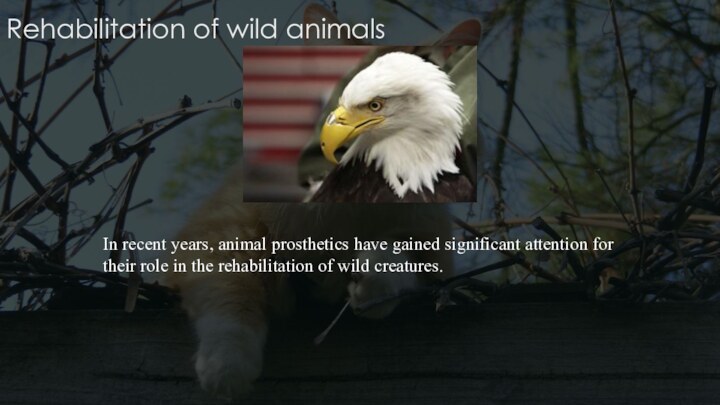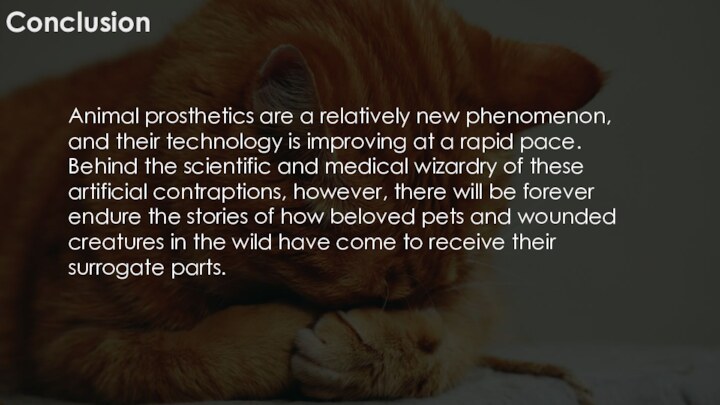- Главная
- Разное
- Бизнес и предпринимательство
- Образование
- Развлечения
- Государство
- Спорт
- Графика
- Культурология
- Еда и кулинария
- Лингвистика
- Религиоведение
- Черчение
- Физкультура
- ИЗО
- Психология
- Социология
- Английский язык
- Астрономия
- Алгебра
- Биология
- География
- Геометрия
- Детские презентации
- Информатика
- История
- Литература
- Маркетинг
- Математика
- Медицина
- Менеджмент
- Музыка
- МХК
- Немецкий язык
- ОБЖ
- Обществознание
- Окружающий мир
- Педагогика
- Русский язык
- Технология
- Физика
- Философия
- Химия
- Шаблоны, картинки для презентаций
- Экология
- Экономика
- Юриспруденция
Что такое findslide.org?
FindSlide.org - это сайт презентаций, докладов, шаблонов в формате PowerPoint.
Обратная связь
Email: Нажмите что бы посмотреть
Презентация на тему What are animal prosthetics
Содержание
- 2. Introduction"One small step for a dog" can
- 3. THERE HAS NEVER been a better time
- 4. The main partThere are a number of
- 5. OSCARINJURY A combine harvester severed both of
- 6. WINTERINJURY Caught in a crab trap that
- 7. PENNY: WOLFHOUNDINJURY Leg amputated after a bout
- 8. CHRISIE: SANDHILL CRANEINJURY Leg amputated after a
- 9. MOLLY: APPALOOSA-SHETLAND PONYINJURY Lower leg amputated after
- 10. Rehabilitation of wild animalsIn recent years, animal
- 11. Naki’oNaki’o was just a puppy when he
- 12. Problems with animal prosthetics - a prosthetic
- 13. ConclusionAnimal prosthetics are a relatively new phenomenon,
- 14. Скачать презентацию
- 15. Похожие презентации
Introduction"One small step for a dog" can in fact end up as "one giant leap for mankind," Noel Fitzpatrick said, a neuro-orthopedic veterinary surgeon based in the United Kingdom.














Слайд 3 THERE HAS NEVER been a better time to
be an injured animal. Thanks to some creative prosthetists
and veterinarians, creatures that lose hoofs, paws, or tails can be made whole again.
Слайд 4
The main part
There are a number of other
types of animal prosthetics as well, many of which
are in early stages of development. In large-breed dogs, for example, the lifelong condition hip dysplasia may require total hip replacement to restore joint function. Paralleling developments in human medicine, veterinarians have developed titanium prosthetic hips for canines. Although refinement of the devices and of the procedures for their insertion is ongoing, early prototypes have already given many affected dogs a second chance for a healthy, active life.
Слайд 5
OSCAR
INJURY A combine harvester severed both of Oscar's
rear paws
After a combine harvester severed both of
Oscar's rear paws, the poor kitty underwent surgery in November 2009 at Fitzpatrick's clinic. The surgeon drilled holes in Oscar's remaining rear ankle bones and implanted titanium pegs called ITAPs (intraosseous transcutaneous amputation prosthetics).
Слайд 6
WINTER
INJURY Caught in a crab trap that cut
off circulation, she lost her tail and two vertebrae.
To
create a new tail for Winter, Kevin Carroll, a VP at Hanger Prosthetics and Orthotics and one of the world’s leading prosthetists, and prosthetist Dan Strzempka worked with a chemical engineer to develop something they call Winter’s gel. It’s a rubbery sock made of thermoplastic elastomer. The trainer rolls it onto Winter’s stump, then slips an anatomically correct tail (based on three-dimensional imaging of Winter’s body) over it. The gel has been such a success that prosthetists, including some at Walter Reed Army Medical Center, have begun using it for human patients. Winter’s gel, Carroll says, is softer and less irritating than other liners. It’s especially helpful for keeping the prosthetics of amputee athletes in place when their skin becomes slick with sweat.
Слайд 7
PENNY: WOLFHOUND
INJURY Leg amputated after a bout with
osteosarcoma (bone cancer)
Denis Marcellin-Little, a veterinary orthopedist, and
Ola Harrysson, an engineering professor, both at North Carolina State University, have custom-designed prosthetics for a number of cats and dogs missing legs. Penny received a replacement limb about six months ago after bone cancer left her with three legs. Marcellin-Little designed the leg in conjunction with colleagues at Bio-Tech Prosthetics and Orthotics in Durham, North Carolina. The foam-lined prosthetic, made of thermoplastic, nylon, and Velcro, curves forward, which prevents it from getting caught on things like stairs. The rounded paw helps with shock absorption. Marcellin-Little is working on a study to determine how foot shape influences the gait of dogs with prosthetics.
Слайд 8
CHRISIE: SANDHILL CRANE
INJURY Leg amputated after a flying
golf ball shattered the bone
Lee Fox, who runs Save
Our Seabirds in Sarasota, Florida, got tired of euthanizing injured sandhill cranes. (The big-bodied, spindly- legged birds just can’t manage on one leg.) So she became an ad hoc prosthetist, outfitting her one-legged sandhills with devices she jury-rigged out of PVC pipe and a sink stop. She heard about Kevin Carroll’s work with Winter and invited him to come look at her birds. Carroll took plaster casts of two of the sandhills and fitted them with updated limbs. Today they strut around on his custom-designed creations like feathered Oscar Pistoriuses. Chrisie’s prosthetic is lined with the same gel used in Winter’s tail.
Слайд 9
MOLLY: APPALOOSA-SHETLAND PONY
INJURY Lower leg amputated after a
pit bull attack
Molly’s first prosthetic was made of acrylic,
aluminum, and fiberglass; it was created by Gary Sod, a vet at Louisiana State University who was part of the team that amputated her leg to save her life. Her current prosthetic (shown), one of six she’s had over the years, was designed by Dwayne Mara of Bayou Orthotic & Prosthetic, who keeps making improvements to it. For his part, Sod is working on another approach: osseointegration—attaching the prosthetic directly to what remains of the bone—for large quadrupeds. He has successfully attached implants to bone and is experimenting with the best way to connect a prosthetic to the skin.
Слайд 10
Rehabilitation of wild animals
In recent years, animal prosthetics
have gained significant attention for their role in the
rehabilitation of wild creatures.
Слайд 11
Naki’o
Naki’o was just a puppy when he was
found in an icy cellar in an abandoned home,
his owner was found dead. The poor pup’s paws and part of his tail were frozen into a puddle. This now homeless dog had to have all four paws, and his tail amputated due to frostbite.
Слайд 12
Problems with animal prosthetics
- a prosthetic can
be created perfectly to fit an animal, there may
still be an issue getting the animal to use it;- variety of animals;
- most veterinarians have never studied prosthetics;
- lack of data is a problem.





























